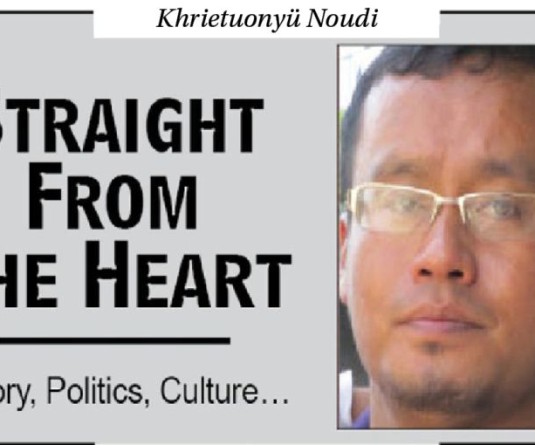
Lemwang Chuhwanglim
Researcher & Activist
A tourist, who recently visited Longwa (a Konyak village) said, “oh those architecture took a toss today! Had a good laugh! - to whoever the person was who thought it so wise to turn the Angh of Longwa’s house into an ugly concrete structure! - please Konyak friends ask around and stick to the original at least with such priceless addresses!” is the response to current scheme of reconstructing Angh’s palace with concrete wall.
Longwa village in Mon district is known far and wide for its peculiar setting. Firstly, the village in theory is a center to international trade and market. Secondly, the international boundary between India and Myanmar cuts through the heart of the village. Third and a prominent making of Longwa village is the great Ahng’s house in its full traditional glory standing tall Angh’s traditional palace capturing the international boundary of India and Myanmar. But the international boundary has not forgiven the Angh’s house for it has not spared His kitchen on the Indian side and his bed room to the Burmese. This eminent construct has caught the imagination of both the outsiders and locals. It is here that tourist flocks into Longwa to see the village in its entirety and more so the great Angh traditional house cutting through India and Myanmar. Longwa people are more hardworking, hospitable, kind and intelligent. They concurrently expose to modernity of two nations (India and Myanmar) almost every day in many aspects in culturating time immemorial cultural and traditional. Such magnificent village rivets people for implementing numerous development activities in the village for it has illuminating history, culture, social and political significance.
Development upgrades moment for people, place and time – it uplifts the status of community in association with cultural affinities and people’s attention towards retrospection of one’s own position contextualizing the global dynamism. However, development without introspection on demolishing history and culture of community brings despair than peace. For instance, the current scheme avails to demolish cultural heritage of Longwa Angh’s building to erect concrete walls would remain the unpleasant history tomorrow.
Development and culture are two social inevitable phenomena among many which exist inseparable and remain associated within human civilization. Each Culture is autonomous, unique, and diverse which symbolically express historical desires. The functional notion of culture is that it primarily solves problem and provides fundamental prerequisites of the people. Certainly culture exists because people could feed and house themselves (Lindholm. 2007). Similarly, development appears as process of human desires towards seeking additional action. Restoration and preservation of cultural heritage is not the new idea today. It has been discussed in the Athen Charter of Restoring Historical monument in 1931 (Frediani. 2013). Deteriorating culture through natural calamities such as cyclone, volcano, earthquake, flood, drought and famine cannot be prevented but it is feasible that human action to destroy cultural heritage is preventable through different means based on every different act of the people.
Within this context, the demolition of the traditional Angh’s house of Longwa with an intention to rebuild it with concrete walls and in somewhat modern architectural approach has largely negated two significant outcomes. (a) Traditions are invented and developed in time and space but while not destroying at the cost of another tradition. Angh’s house construction is a collective effort which binds people together in the village. This practice precedes a collective responsibility accompanied by feasting and merrymaking, not as a burden. In addition, it encompasses social harmony, identity, community workmanship and belongingness. This culture proliferate the indigenous organized sustainable social system and structure through local wisdom and knowledge. However, to despair, the current traditional Angh’s house demolition undermines this positive aspect and brings threshold to cessation of tradition and culture. (b) Economically the current reconstruction of the Angh house in Longwa village through modern technology and in modern architectural form destroys the influx of visitors and tourists to the village. Hence, it relegates the growth of sustainable culture and economy.
Konyaks appreciate and acknowledge any individual’s development initiative in interior place like Konyak area. However, failure to identify negative impact on culture and tradition through development based on personal political discretion remains venomous towards relinquishing normal way of life (psychologically, physically, culture, history and identity) of the community. Such absurdity scheme hegemonizes even a great, literate and educated Naga towards unconscious act without explicating damages emanated upon one’s own culture and tradition, as a result. Such ramification is the root cause of destroying community, culture and traditional integrity. Moreover, intentional act which destroys the significance of culture and tradition in the pretext of development in favor of personal benefits is the worst.
Angh and Anghya culture among the Konyaks has reduced due to numerous factors like social, politics and religion. As a result, predominant tourists and Konyaks divisively presume that this culture has become an absolute insignificant, which is untrue; to claim absolute death of Angh and Anghya culture insignificantly, for personal argument is an illusion. Though Konyak political leaders from towns and cities have fragmented the Angh and Anghya culture, every grassroots in village assembles the significance of it in everyday life. One of the evidences of it has been indicated in the recent Konyak Aoleang where Angh and Anghya’s traditional costumes significantly differ from the common people. If Angh and Angya culture is dead today, such significance would remain invisible. The Konyak in general grief and regret today for commoditizing culture to politics based on power discrimination. People may utilize the concrete wall Longwa’s Angh house to shelter visitors; subsequently, rebuild a big traditional house for the Angh beside it. One should understand that rebuilding Angh’s house traditionally does not mean rejecting development. It is preserving and conserving culture and identity of the Angh and his people. There is a hope for the revival of Angh and Anghya culture through the initiative of few concerned Konyaks to preserve yesterday and today for the future generation.





